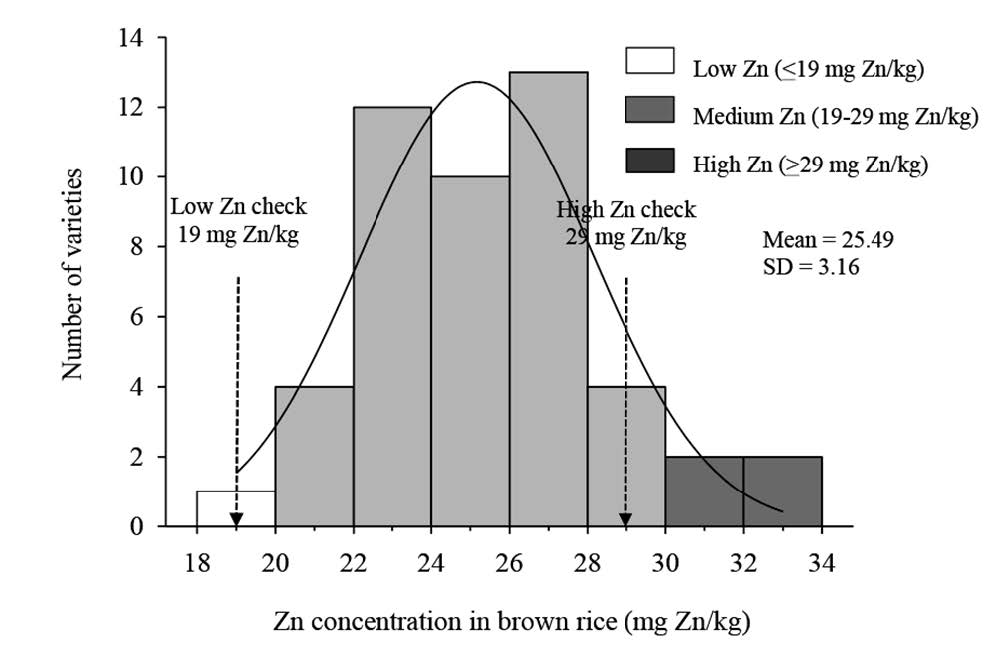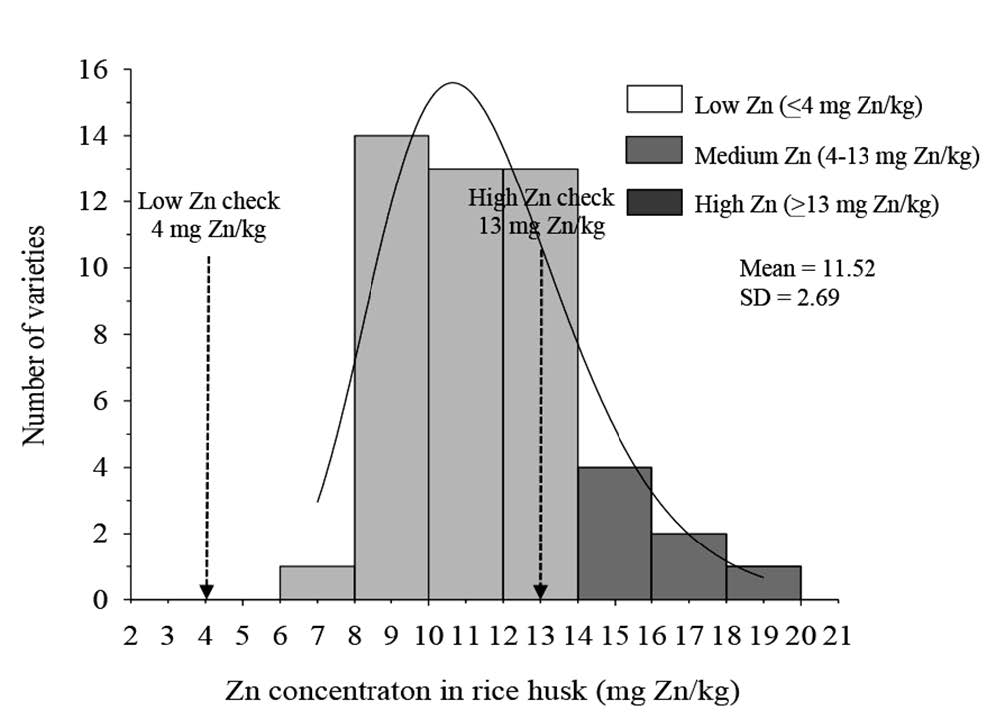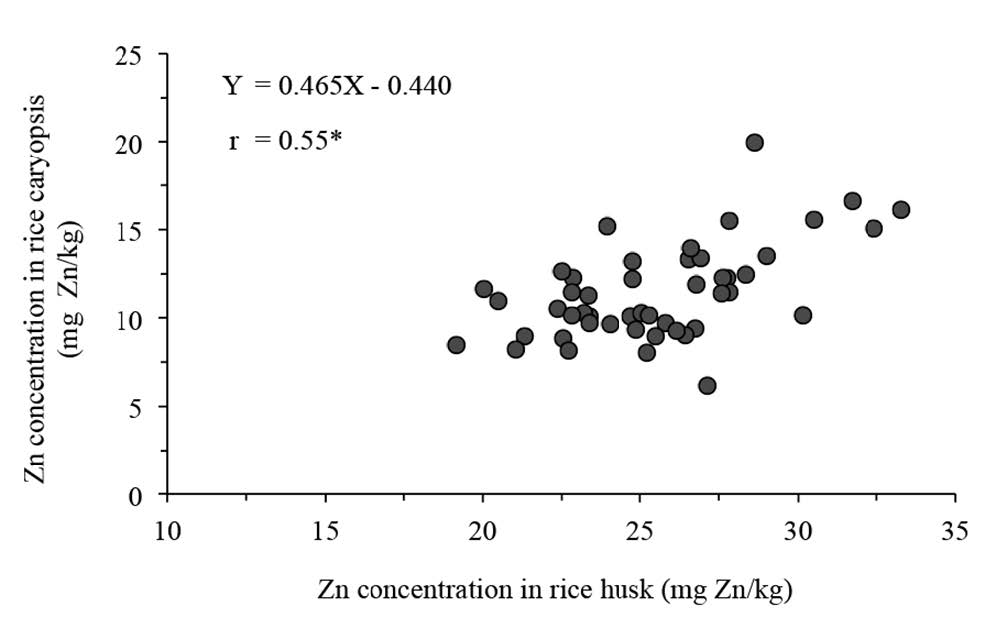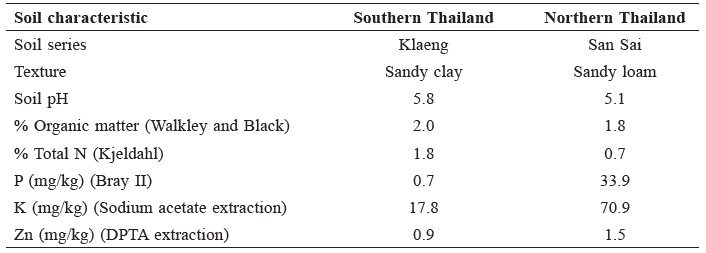
Variation of Zinc Concentration in Rice Caryopsis and Husk among Southern Rice Varieties Grown in Southern and Northern Thailand
Nantiya Panomjan, Sansanee Jamjod, Benjavan Rerkasem,Bernard Dell and Chanakan Prom-u-thaiPublished Date : 2019-08-23
DOI : 10.12982/cmujns.2016.0001
Journal Issues : Number1 ,January - April 2016
ABSTRACT
This study evaluated the concentration of Zn in rice caryopsis (intact with pericarp and embryo) and husk (palea and lemma) among rice varieties from southern Thailand and whether the pattern in the Zn concentration of selected varieties was altered by production in a different genetic resource area in northern Thailand. Forty-eight southern rice varieties were grown in a paddy field at Phatthalung Rice Research Center, Thailand, designated as the southern location. Seeds of each variety were harvested and analyzed for Zn concentration in the caryopsis and husk and compared with the standard check varieties with low (RD21) and high (Namroo) Zn concentrations. Four varieties with different Zn concentrations in the caryopsis were selected from among the 48 above varieties and grown in a demonstration field at Chiang Mai University, Thailand, designated as the northern location, for examining the effect of planting location on Zn concentration in the caryopsis. Zn concentrations ranged widely, from 19.2 to 33.3 mg Zn/kg in the caryopsis and from 6.2 to 20.0 mg Zn/kg in the husk among the 48 southern varieties planted in the southern location. Zn concentrations in the caryopsis and huskplanted at the southern location correlated significantly (r = 0.55*). The rice varieties Chaw Gam Preud, Leuang Hawm, Mai Yah, and Nahn Hak had the highest caryopsis Zn concentrations; all were higher than the high standard Zn check variety (29.0 mg Zn/kg). The wide range of Zn concentrations in the caryopsis among rice varieties from southern Thailand provides an opportunity for selective inclusion in breeding strategies to enhance dietary Zn uptake by rice consumers. The caryopsis Zn concentrations were reduced by 20-42% in three out of four southern cultivars grown in northern Thailand; this indicates the importance of considering the environment and agronomic practices when selecting cultivars with high Zn concentrations in pre-breeding programs.
Keywords: Rice caryopsis, Grain zinc, Local rice, Southern Thailand, Northern Thailand, Planting location
INTRODUCTION
Zinc (Zn) deficiency is a well-documented problem, occurring in both crops and humans. Soil condition is the major cause of Zn deficiency in cereal crops (Alloway, 2008); an estimated 50% of the world’s cereal production areas are affected by constraints in soil Zn supply, leading to decreased crop yields and nutritional quality (Cakmak, 2002). Diets low in available Zn cause severe health complications, including impairing physical growth, the immune system, and learning (Gibson, 2006). In Southeast Asia, most of the population derives the majority of their nutritional and caloric needs from rice (Hotz and Brown, 2004). Therefore, strategies to decrease the incidence of Zn deficiency among the population by increasing the Zn concentration in rice grain are worth considering. Previous studies have reported a wide variation in Zn concentrations among varieties of rice caryopsis (with intact pericarp and embryo), e.g., 14 to 58 mg Zn/kg in a germplasm collection at the International Rice Research Institute (Gregorio, 2002) and 17 to 59 mg Zn/kg among Thai rice varieties (Saenchai et al., 2012). Breeding and selection of Zn-rich rice varieties have been confirmed as a means to increase the intake of this nutrient in rice eaters (Welch and Graham, 2004; Bouis and Welch, 2010).
Thai rice varieties are genetically diverse (Chang, 1976; Dennis, 1987), with many traditional varieties collected for conservation. This resource is invaluable for future rice breeding programs in Thailand. In particular, genetic diversity allows local farmers to select for specific traits, such as starch quality (Pusadee et al., 2014). Research has been undertaken on variation in grain quality for fragrant (aromatic) rice landraces (Prathepha and Srisa-Ard, 2014), colored rice (red and black rice varieties) (Sompong et al., 2011a; Sompong et al., 2011b) and waxy (glutinous) rice (Chakhonkaen et al., 2012), with a focus on special properties, such as nutritional and cooking qualities for the international market. Interest has also been expressed in developing rice products for other benefits, such as cosmetics.
For Thai rice, variation in Zn concentration of local upland rice from the north (ranging from 17 to 26 mg Zn/kg) and improved and modern rice varieties in the central plain (ranging from 39 to 59 mg Zn/kg) have been reported previously (Saenchai et al., 2012; Jaksomsak et al., 2014a; Jaksomsak et al., 2014b). However, the southern rice germplasm has not yet been evaluated for Zn concentration and other grain qualities. Even though the rice growing area in southern Thailand is only about 10% of Thailand’s total rice growing area, some southern rice varieties are well known for their premium quality, such as Sang Yod and Leb Nok. Southern Thailand, sitting between the Indian and Pacific Oceans, experiences a different climate regime than rice production areas elsewhere in Thailand and this may influence grain quality, including grain Zn concentration. For example, in northern Thailand, where climate and soil differ between upland and lowland rice production areas, the Zn concentration in rice caryopsis was lower (21 to 38 mg Zn/kg) for upland than paddy rice (28 to 41 mg Zn/kg) (Jaksomsak et al., 2014b). To explore this further, this study evaluated the variation in Zn concentration in non-glutinous local rice varieties from southern Thailand, and whether the pattern in the grain Zn concentration of selected varieties was altered by production in a different genetic resource area in northern Thailand.
MATERIALS AND METHODS
Plant culture
One southern – Phatthalung Rice Research Center (PRRC; latitude 7° 57’ N, longitude 100° 13’ E and altitude 27 m AMSL) – and one northern – Chiang Mai University (CMU; latitude 18° 47’ N, longitude 98° 59’ E and altitude 330 m AMSL) – location were selected for field trials in Thailand. The southern experiment was undertaken in 2011-2012 with 48 local varieties from southern Thailand. The northern experiment was undertaken in 2012-2013 with four varieties selected among the 48 southern varieties. The experiments were conducted in randomized complete block design with three independent replications. Seed for the southern experiment was obtained from the conservation field at PRRC. From the results of Zn concentration in the rice caryopsis of the 48 southern varieties, 4 varieties representative of low (Look Paw), medium (Sang Yod and Look Krahd), and high (Chaw Gam Preud) Zn in the caryopsis were selected for use at the northern location.
Plants were grown as lowland rice, i.e. on wetland soil. Briefly, the seeds were soaked in water overnight and incubated moist until germination and raised as seedlings for 30 days in the field. Single seedlings of each genotype were transplanted into hills at 0.25x0.25 m spacing in 2x5 m2 plots in three replicated blocks. Fertilizer, as 15N-15P2O5-15K2O, was applied twice, at the rate of 93.75 kg/ha, at 25 and 45 days after transplanting. Weeds were removed by hand. Seed was harvested at maturity by hand, sun-dried to 14% moisture content, dehusked manually, and the Zn concentration determined.
Chemical analysis
Sub-samples of rice caryopsis (0.5 g) and husk (0.2 g) were oven-dried at 70°C for 72 hours and dry-ashed in a muffle furnace at 535°C for 8 hours. The ash was dissolved in HCL (1:1; HCl:deionized water) and the Zn concentration determined using an atomic absorption spectrophotometer (Z-8230 Polarized Zeeman AAS, Hitachi, Japan) (Allan, 1961). Soybean leaf reference material and seed samples of the standard low (RD21) and high (Namroo) Zn varieties were included in each analysis batch as a certified reference standard to check the quality of plant analysis (“check varieties”). The standard low and high Zn check varieties were previously used in grain Zn analysis (Saenchai et al., 2012; Jaksomsak et al., 2015).
Data analysis
The data were subjected to analysis of variance (ANOVA) and means that were significantly different were separated at P<0.05 by the least significant difference (LSD) test. The Pearson correlation model was used to evaluate the relationship between variety and Zn concentration in the husk and caryopsis.
RESULTS
The Zn concentration in rice caryopsis varied widely among the 48 rice varieties from southern Thailand grown at the southern location, ranging from 19.2 to 33.3 mg Zn/kg (Figure 1). Forty-four varieties had a medium to high Zn concentration in the caryopsis (20 to 29 mg Zn/kg) compared with the low (RD 21) and high (Namroo) Zn concentration, the standard check varieties, which had 19 and 29 mg Zn/kg, respectively. However, four varieties, Chaw Gam Preud, Leuang Hawm, Mai Yah, and Nahn Hak, had higher grain Zn concentrations than the high-Zn standard check variety. Furthermore, a wide variation in Zn concentration was also observed in the husk among the 48 varieties (Figure 2) – from 6.2 to 20.0 mg Zn/kg, with 4 mg Zn/kg and 13 mg Zn/kg in the low and high Zn standard check varieties, respectively. Thirty-four varieties had a medium Zn concentration (4-13 mg Zn/kg) – between the Zn concentration in the husk of the low and high standard check varieties – and 14 varieties had a high Zn concentration in the husk (>13 mg Zn/kg) – higher than the Zn concentration in the husk of the high standard check variety.

Figure 1. Variation in Zn concentration in rice caryopsis among 48 varieties from southern Thailand, grown at the southern location. Mean averaged from 3 replications.

Figure 2. Variation in Zn concentration in the husk of 48 rice varieties from southern Thailand, grown at the southern location. Mean averaged from 3 replications.
The Zn concentration in the caryopsis and Zn concentration in the husk for the 48 southern rice varieties grown at the southern location correlated significantly (r= 0.55, p< 0.05) (Figure 3).

Figure 3. Relationship between Zn concentration in the caryopsis and husk of 48 varieties from southern Thailand grown at the southern location.
Seed of the four selected rice varieties (Look Paw, Sang Yod, Look Krahd, and Chaw Gam Preud) from southern Thailand were grown in the north at Chiang Mai University to compare the Zn concentration in the caryopsis between the two locations. The soil series at the two locations differed; the north contained more clay and was more acidic than the south. In the south, soil N concentration was 3 times higher than the north, and the P, K, and Zn concentrations were 48, 4, and 2 times lower than the north, respectively (Table 1). In contrast to the lower soil Zn in the south than the north, three of the selected varieties had higher Zn concentrations in the caryopsis when grown in the south compared to the north. (Figure 4). The caryopsis Zn concentrations of Sang Yod (medium Zn), Chaw Gam Preud (high Zn) and Look Krahd (medium Zn) were 20-42% higher when grown in the south, but there was no effect of location on the grain Zn concentration in Look Paw (low Zn).
Table 1. Soil characteristics of the rice cultivation sites at the southern (Phatthalung Rice Research Center, Phatthalung) and northern (Chiang Mai University, Chiang Mai) Thai locations.

Note: All values are means of 10 replications for soil sampled from 0 to 15 cm depth.

Figure 4. Zinc concentration in rice caryopsis of four rice varieties from southern Thailand grown in wetland rice fields at Phatthalung Rice Research Center (south) and Chiang Mai University (north), Thailand.
DISCUSSION
The variation in Zn concentration in rice caryopsis among the 48 southern varieties grown in southern Thailand (19 to 33 mg Zn/kg) was within the range of 17 to 59 mg Zn/kg observed by Saenchai et al. (2012) for the northern Thai rice varieties. The correlation between Zn concentration in the caryopsis and husk among 48 rice varieties grown in the south suggests that the husk is an important source of Zn for the caryopsis; this agrees with the findings of other researchers (Gao et al., 2012; Impa et al., 2013). The amount of Zn in the husk is also a major source of Zn transport to the grain during early germination (Prom-u-thai et al., 2012).
Varieties with high Zn concentration provide a useful source of genetic material for future breeding programs, for example, Chaw Gam Preud, Leuang Hawm, Mai Yah, and Nahn Hak, with high Zn concentrations in the caryopsis, and Ekoo3, with a high Zn concentration in the husk. The positive correlation between Zn concentration in the caryopsis and husk is not recommended for screening, as the correlation is quite weak. Further investigation of specific varieties is required to understand the relative importance of reproductive tissues in Zn supply and transport for the caryopsis.
In comparing the southern and northern growing locations, preliminary findings on the four cultivars grown in common at the two, but in different years, showed that grain Zn concentration was higher in the south than the north, despite the lower levels of Zn in the southern soil. It is unclear to what extent climate and soil might have affected supply of Zn to the grain. Studies elsewhere have shown interactions between genotype and the environment (Gregorio, 2002; Chandel et al., 2010) and that the caryopsis Zn content was affected by soil texture, pH, and organic matter content (Chandel et al., 2010). Although the soil Zn concentration in the south was about two times lower than the north, the south had higher organic matter and soil N than the north. In particular, the N-nutritional status is critical in root uptake and root-to-shoot translocation of Zn, as well as Zn immobilization during both vegetative and generative stages of development (Erenoglu et al., 2011). Specific studies where N fertilization have enhanced seed Zn are described by Hao et al. (2007) and Dash et al. (2010). Further work is required to ascertain the influence of environment on Zn uptake by rice caryopsis in southern Thailand. This study showed a wide variation in grain Zn in the caryopsis and husk among 48 southern rice varieties grown in southern Thailand. Grain Zn concentration was higher when grown in the south than the north, despite the lower levels of Zn in the southern soil. This provides a useful source of genetic material for potentially improving the Zn content of rice caryopsis in southern Thailand, as several varieties were found to have higher grain Zn concentration than the standard high Zn check variety.
ACKNOWLEDGEMENTS
This research was financially supported by a Thai Government Science and Technology Scholarship from the Ministry of Science and Technology, Thailand, The Graduate School and Lanna Rice Research Center, Chiang Mai University, and Thailand Research Fund (RSA5580056). The Phatthalung Rice Research Center, Thailand is also acknowledged for providing rice seed for this experiment.
REFERENCES
Allan, J.E. 1961. The determination of zinc in agricultural materials by atomic-absorption spectrophotometry. Analyst 86(1025): 530-534
Alloway, B.J. 2008. Zinc in soils and crop nutrition. International Zinc Association and International Fertilizer Industry Association, Brussels and Paris.
Bouis, H.E., and R.M. Welch. 2010. Biofortification-a sustainable agricultural strategy for reducing micronutrient malnutrition in the global south. Crop Science 50(2): S20-S32.
Cakmak, I. 2002. Plant nutrition research: Priorities to meet human need s for food in sustainable ways. Plant and Soil 247(1): 3-24.
Chakhonkaen, S., K. Pitnjam, W. Saisuk, K. Ukoskit, and A. Muangprom. 2012. Genetic structure of Thai rice and rice accessions obtained from the International Rice Research Institute. Rice 5: 19.
Chandel, G., S. Baneree, S. See, R. Meena, D.J. Sharma, and S.B. Verulkar. 2010. Effects of different nitrogen fertilizer levels and native soil properties on rice grain Fe, Zn and protein contents. Rice Science 17(3): 213-227.
Chang, T.T. 1976. The origin, evolution, cultivation, dissemination and diversification of Asian and African rices. Euphytica 5: 425-441.
Dash, D., H. Patro, R.C. Tiwari, and M. Shahid. 2010. Effect of organic and inorganic sources of nitrogen on Fe, Mn, Cu and Zn uptake and content of rice grain at harvest and straw at different stages of rice (Oryza sativa) crop growth. Advances in Applied Science Research 1(3): 36-49.
Dennis, J.V. 1987. Farmer management of rice variety diversity in Northern Thailand. Ph.D. Thesis, Cornell University.
Erenoglu, E.B., U.B. Kutman, Y. Ceylan, B. Yildiz, and I. Cakmak. 2011. Improved nitrogen nutrition enhances root uptake, root-to-shoot translocation and remobilization of zinc (65Zn) in wheat. New Phytologist 189(2): 438-448.
Gao, X.P., E. Hoffland, T. Stomph, C.A. Grant, C.Q. Zou, and F.S. Zhang. 2012. Improving zinc bioavailability in transition from flooded to aerobic rice. A review. Agronomy for Sustainable Development 32(2): 465-478.
Gibson, R.S. 2006. Zinc: the missing link in combating micronutrient malnutrition in developing counitries. Proceedings of the Nutrition Society 65(1): 51-60.
Gregorio, G.B. 2002. Progress in breeding for trace minerals in staple crops. The Journal of Nutrition 132(3): 500S-502S.
Hao, H.L., Y.Z. Wei, X.E. Yang, Y. Feng, and C.Y. Wu. 2007. Effects of different nitrogen fertilizer levels on Fe, Mn, Cu and Zn concentrations in shoot and grain quality in rice (Oryza sativa). Rice Science 14(4): 289-294.
Hotz, C., and K.H. Brown. 2004. Assessment of the risk of zinc deficiency in populations and options for its control. Food and Nutrition Bulletin 25(Supplement 2): S91-S204.
Impa, S.M., M.J. Morete, A.M. Ismail, R. Schulin, and S.E. Johnson-Beebout. 2013. Zn uptake, translocation and grain Zn loading in rice (Oryza sativa L.) genotypes selected for Zn deficiency tolerance and high grain Zn. Journal of Experimental Botany 64(10): 2739-51.
Jaksomsak, P., P. Sangruan, G. Thomson, B. Rerkasem, B. Dell, and C. Prom-uthai. 2014a. Uneven Distribution of Zinc in the Dorsal and Ventral Sections of Rice Grain. Cereal Chemistry 91(2): 124-129.
Jaksomsak, P., N. Yimyam, B. Dell, C. Prom-u-thai, and B. Rerkasem. 2014b. Variation of seed zinc in a local upland rice germplasm from Thailand. Plant Genetic Resource In press: 1-8.
Prathepha, P., and K. Srisa-Ard. 2014. Population differentiation of two Thai fragrant rice landraces revealed by SSR marker analysis. Thai Journal of Genetics 7(3): 183-191.
Prom-u-thai, C., B. Rerkasem, A. Yazici, and I. Cakmak. 2012. Zinc priming promotes seed germination and seedling vigor of rice. Journal of Plant Nutrition and Soil Science 175(3): 482-488.
Pusadee, T., P. Oupkaew, B. Rerkasem, S. Jamjod, and B.A. Schaal. 2014. Natural and human-mediated selection in a landrace of Thai rice (Oryza sativa). Annals of Applied Biology 165(2): 280-292.
Saenchai, C., C. Prom-u-thai, S. Jamjod, B. Dell, and B. Rerkasem. 2012. Genotypic variation in milling depression of iron and zinc concentration in rice grain. Plant and Soil 361(1-2): 271-278.
Sompong, R., S. Siebenhandl-Ehn, E. Berghofer, and R. Schoenlechner. 2011a. Extrusion cooking properties of white and coloured rice varieties with different amylose content. Starch-Starke 63(2): 55-63.
Sompong, R., S. Siebenhandl-Ehn, G. Linsberger-Martin, and E. Berghofer. 2011b. Physicochemical and antioxidative properties of red and black rice varieties from Thailand, China and Sri Lanka. Food Chemistry 124: 132-140.
Welch, R.M., and R.D. Graham. 2004. Breeding for micronutrients in staple food crops from a human nutrition perspective. Journal of Experimental Botany 55(396): 353-64.
Nantiya Panomjan1,2*, Sansanee Jamjod1,5, Benjavan Rerkasem4, Bernard Dell3 and Chanakan Prom-u-thai1,5*
1 Department of Plant Science and Natural Resources, Faculty of Agriculture, Chiang Mai University, Chiang Mai 50200, Thailand
2 Department of Plant Science, Faculty of Technology and Community Development, Thaksin University, Phatthalung 93100, Thailand
3 School of Veterinary and Life Sciences, Murdoch University, Perth 6150, Australia
4 Plant Genetic Resource and Nutrition Laboratory, Faculty of Agriculture, Chiang Mai University, Chiang Mai 50200, Thailand
5 Lanna Rice Research Center, Chiang Mai University, Chiang Mai 50200, Thailand
*Corresponding authors. E-mail: n_numkum@hotmail.com, chanakan.p@cmu.ac.th
Total Article Views

